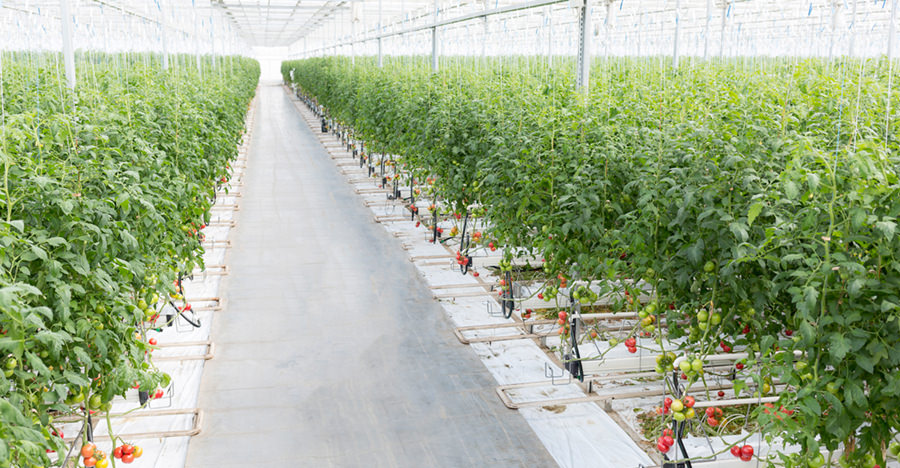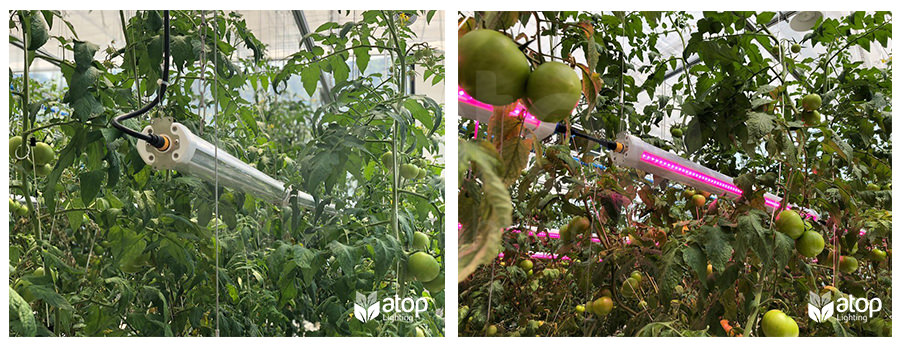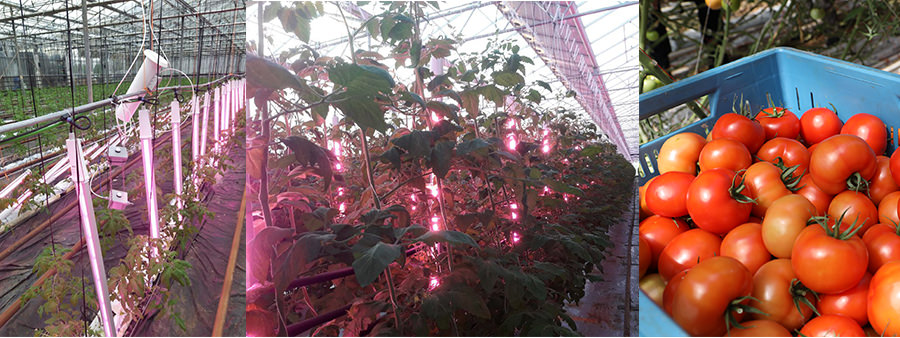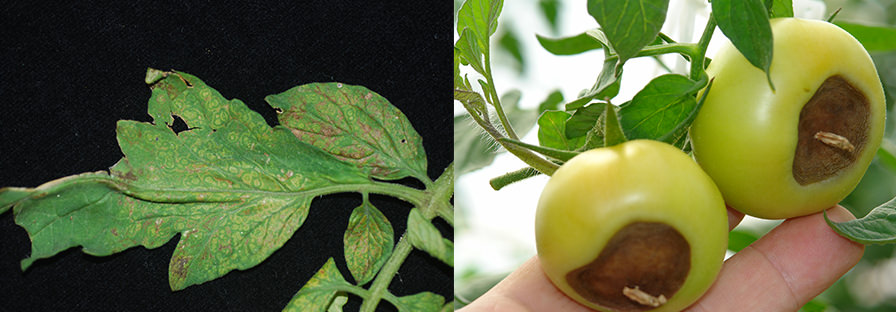6 Little-Known Tips to Grow Tomatoes Better in Greenhouse
Tomato is a common food in our daily life. There are abundant antioxidant lycopene in tomato that is beneficial for health. Tomato also contains a great number of vitamin C, vitamin K, and potassium. Former benefits make tomato being popular, which means growing tomatoes is profitable in high possibility among various crops. Growers used to grow tomatoes with soil in the open filed. Nowadays, more and more growers utilize greenhouse and soilless growing methods to grow tomatoes for year-round production and higher yields. However, the lack of knowledge about stricter requirements of growing tomatoes and higher cost of building a greenhouse may result in a loss of money. Therefore, the post would show you some tips to grow tomatoes better in greenhouse.

1. Growing tomatoes in greenhouse is not easy
First of all, we should have a clear perception that it is not easy to grow tomatoes in greenhouse. Every factor that is related with growth should be taken into account. Growing tomatoes in spring or fall is of huge difference in costs, production, and profits. Generally speaking, growing tomatoes in spring is more profitable because each tomato plant create more fruits and heating costs are saved by lower light intensity. Managing tomatoes in greenhouse needs a lot of effort. Improper growing environment, including temperatures, humidity, lights, and other factors, causes the problems with pets and diseases. Only having knowledge and practices of providing optimal growing environment for tomatoes, can growers reap more profits and producing premium quality. Labor cost is non-ignorable for growing tomatoes in greenhouse. A large number of workers are needed for production practices and taking care of the tomatoes. Furthermore, workers should have basic knowledge about growing tomatoes for higher efficiency.
2. Choose appropriate cultivar or variety
When you start to grow tomatoes, choose appropriate cultivar or variety. There are multiple types of tomatoes in market, do a research before growing to select the cultivars or variety that are actually suitable for growing in greenhouse. Some growers aimed at growing the most profitable one. They may look for the tomatoes that set massive fruit per plant. Higher production can balance the total cost for growing. Some grower want to grow the most salable tomato. They should pay attention to market demands and find the features of desired tomatoes, including the size, color, flavor, shape, etc. Other growers may prefer the tomatoes that are easier for growing. Cultivars or variety have strong disease resistance may be the good choice. Another factor associates with cultivar or variety is the seed. Though non-hybrid seeds is more expensive than hybrid seeds, they have more stable and better performance. Furthermore, the cost of seeds are less expensive than others included in growing tomatoes in greenhouse.
3. Select a right site for greenhouse
A right site for building greenhouse is the basement of high efficient tomato growing. Tomatoes need more light than other plants. They also require good air movement for better pollination. A site that is in full light and with good ventilation is ideal for growing tomatoes. A open area that is board without shading of trees or buildings would be the best choice for growing tomatoes. The floor should be level to place relevant instruments, like vertical hydroponic tower. A site with uneven floor will cost more time and energy to level the floor. Water supply is also important for soilless cultivation. The site near clean water supply can provide adequate water for irrigation. Shorter distance to water supply saved cost for installing water pipes or conduits as well.
4. Supplemental lights for better growing
Tomato plants are sensitive to light intensity, spectrum, and direction. Full light and high light intensity increase fruit set and help tomato plants grow better. Unlike most plants, tomatoes need large amount of light and higher light intensity. DLI(Daily Light Integral) around 30 mol/m2/day enable tomatoes produce high yields. However, plant growth is limited under solely natural sunlight. Both transparent plastic and glass greenhouse ensure the lights are reflected into the greenhouse to the maximum, but the available sunlight in the greenhouse is around 25 mol/m2/day in common, lower than the optimal DLI for tomatoes growing. There are less lights and lower light intensity during winter and cloudy days. Low light intensity can result blotchy-ripening and other serious diseases. In consequence, supplemental lighting is absolutely needed for growing tomatoes in greenhouse at some periods.

LED grow lights are approved to be effective and less heat supplemental lighting. Addition of LED grow lights improve lighting intensity for the periods that lack of lights. A research showed LED grow lights were able to raise yields up to 25% a week. Desirable production, morphology, yield, and other growth conditions can be reached by applying optimum light spectrum. LED grow lights are proven being to offer full spectrum as well as specific spectrum according to the growth needs. Photon ratio also affects plant growth through influencing photosynthetic rate.
A robust tomato plant is grown with multiple large leaves and fruit sets. Lower hanging tomatoes and leaves are shielded by the upper, thus they are less likely to absorb enough lights. Interlights enhance lighting efficiency as they are placed alongside the top and bottom of the plants or the middle of plants, providing lighting for the lower parts of plants that are shaded by upper leaves.
Atop provides the second version LED interlights - Horti-Reina and Horti Tube Pro. Horti-Reina features a narrow-profile design that minimizes the interception of light. It emits sidewards light distribution, keep your lower leaves get optimal uniform light and result in an increase yield. Horti Tube Pro offers enhanced full spectrum that produces the fastest flowering for plant species grown under artificial lighting. The bioptical gain of far-red light on photosynthetic rate is beneficial to promote plant growth and increase plant yield.

5. Temperature requirements vary from stage
Each growth stage of tomato has different temperature requirements in greenhouse. 18-21 ℃ is great for seed germination. After seed leases unfold, 12-15℃ day temperature and 11-12℃ night temperature is set for a cold treatment. 18-30℃ day temperature and 15-18 ℃ night temperature is favorable for planting greenhouse tomatoes. Improper temperatures are negative to growth. Too low temperatures will weaken nutrient absorption while too high temperatures will threaten plants’ survival. Here is a table about the temperature requirements for growing tomatoes in greenhouse.
|
Growth stage |
Temperature (℃) |
|
|
Night |
Day |
|
|
Seed germination |
18-21 |
18-21 |
|
After seed leaves unfold, lasting for 10-14 days under this temperature |
11-12 |
12-15 |
|
Before plants are transplanted into greenhouse |
15-18 |
18-21 |
|
Flowering and fruiting |
15-18 |
18-30 |
However, temperature in greenhouse is also associated with ventilation and the effects of heaters and cooling machine. Former factors are critical for controlling desired temperature in greenhouse. It is not surprised that the temperature inside the greenhouse is above 80 degrees but only 40 degrees in outside without proper ventilation. Heaters are used for increasing temperature in winter or cloudy days while cooling machines are used for reducing temperature in summer or hot weather. Another matter we should pay attention for is the location of thermostat. If the thermostat is located in the place that is directly shined by sunlight, the reading is doubtless higher than actual temperature.
6. Ways to prevent insects & diseases
Though many factors are controllable for growing tomatoes in greenhouse, insects and disease is not avoidable. Growers should learn the common insects and diseases of greenhouse tomatoes and the ways to solve the problems.
Common greenhouse insects includes white flies, aphids, fruit worms, flea beetles, etc. The primary point to control insects is the sanitation of greenhouse. Plant residue and roots should be removed from greenhouse in time and disinfected with 10% bleach solution. Pipes should be disinfected as well. The use of pesticides are limited in greenhouse, only those low toxicity pesticides are approved. Yellow sticky labels are widely used to control and monitor insects.
Diseases are presented due to the inappropriate growing environment. Botrytis, catfacing, oedema, and blossom end rot are the four common diseases of greenhouse tomato. Botrytis is a fungal pathogens that occur in cool and humid periods. Tomatoes are covered with fuzzy gray pores. It can be prevented by reducing humidity, using labeled fungicides, and adjusting temperature. Catfacing is of high possibility to occur in prevalent low temperature periods, such as fall, winter and spring. Oedema is developed as imbalance water absorption caused by temperature difference between plants and roots in cool and low-light condition. Oedema can be solved by improving ventilation, choosing proper cultivar and balance temperature difference between plants and roots. Adding LED grow lights also contribute to improve the matter. Blossom end rot is raised without sufficient calcium. Providing adequate calcium and moisture in irrigation solution helps to avoid the disease.


